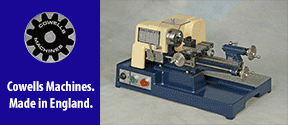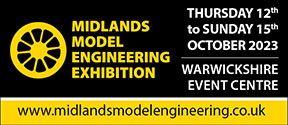Herbert 0V milling machine
| Paul Shackleton | 08/10/2022 07:52:47 |
| 4 forum posts | Hello Sorry if this post is in the wrong forum I have just joined and this looked appropriate.
I have just inherited a Herbert 0V vertical milling machine with minimal tooling, I have a collet chuck but really could do with more collect and a morse adaptor for drilling. Reading some old posts, it looks like it may be a R0 taper fitting for the tooling but I haven’t been able to find any diagrams of the R0 fitting to check it against the chuck I have or any suppliers of R0 to check with them. Any assistants and sources of tooling would be greatly appreciated.
Thanks Paul |
| David George 1 | 08/10/2022 13:44:48 |
2110 forum posts 565 photos | Hi Paul welcom to the forum. Arc Eurotrade is as good as anywhere to start have a look at their web site for a drill chuck, cutters and measuring equipment starting with a electronic caliper and a micromiter or two. A clamping set may be usefull as well if there is not included as well as a vice for holding jobs whilst milling and drilling. https://www.arceurotrade.co.uk/ David Edited By David George 1 on 08/10/2022 13:45:44 |
| Pete Rimmer | 08/10/2022 13:54:55 |
| 1486 forum posts 105 photos | I had one of those for about 12 years, a nice little milling machine. I got 6 collets with mine all imperial, I imagine that was the full set when it was sold new. I was dismayed by the lack of tooling options so I removed the spindle and posted it to (the late) John Stevenson. He let a piece into the end of the spindle and machined it to accept R8 collets. After that, it was a much more useful machine. |
| Paul Shackleton | 08/10/2022 15:08:13 |
| 4 forum posts | Thanks for both sugetions, converting it to R8 sounds like the best long term solution pity John Stevenson isnt around any more. Arc Euro Trade looks like a useful source, i have had a look on there website, it doesnt look like they do anything to fit but i have sent an enquiry just in case they can sugest anything. I have a Colchester Triumph 2000 lathe so have the most of the basic kit, never owned a miller before although i have worked with them a bit in the past at a relitive engineering works. |
| Pete Rimmer | 08/10/2022 15:54:21 |
| 1486 forum posts 105 photos | If you have a lathe with a 4-jaw and fixed steady you could easily do the work yourself. Pull the spindle and put it in the 4-jaw. Turn out a pocket in the end and press in a slug of something tough like EN24 steel. Bore it and rough turn to your taper angle by holding the back end in your 4-jaw and the front bearing running on the fixed steady. Now re-assemble the milling spindle and tip the head over to the half-angle of the R8 taper. Clamp a toolpost on the table, line it up dead on the centre line of the spindle and use the Z handwheel to lift the knee and cut the taper. Now you'll have a R8 taper that's running perfectly true to the spindle. That's how I did mine.
There's some more useful info in the album I have made. Have a look. Pete. |
| Paul Shackleton | 09/10/2022 07:37:06 |
| 4 forum posts | Thanks Pete, i was concerned about how it would be possible to guarantee it all ran true, I haven't been able to find the specification of the R8 dimensions but will keep googling! |
| Howard Lewis | 09/10/2022 08:55:38 |
| 7227 forum posts 21 photos | Is it possible that the Spindle is an INT 30, or 40? If so, it may be possible to make or buy and adaptor to whatever taper you wish to use. The "Tools - n- Gizmos" site lists a range of tapers, so R8 may be listed. If not there will be other places where the dimensions are available. Howard |
| John MC | 09/10/2022 09:02:08 |
464 forum posts 72 photos | When I bought my Herbert 0V I replaced the spindle taper with a 4MT, the main reason being that I had 4MT tooling from the mill the 0V replaced. I finished the taper exactly as Pete R described. Not that easy to do but well worth the effort. With hindsight, I would have preferred to use a 30INT taper. The advantage of the International taper is that its not self locking unlike a Morse. Both Morse and International tapers give a far more better location than R8. Also, R8 mountings are known to wear on the parallel diameter with the inevitable affect on accuracy. Providing the mounting is accurate in the first place I don't think that will be a problem with the amount of use our machines get! Incidentally, I replaced the existing bearing arrangement with tapered rollers for a more ridgid support of the spindle. Doing this enabled me to reduce the overhang of the tooling and gain a little more vertical capacity. I have an electronic copy of the manual for this machine, if the OP wants a copy let me know.
|
| Paul Shackleton | 09/10/2022 09:25:48 |
| 4 forum posts | Thanks for all the comments i hadn't considered all the options of spindle taper as i had always just used what was to hand in my uncles workshop! the 30INT looks more common from what i see around some of the engineering shops i work in so is well worth looking at for future proofing/tool availability (perhaps?). thanks for all you help and advice, only just joined this forum but its great to have all the positive responses from keen and helpful people. |
| Emgee | 09/10/2022 09:51:41 |
| 2610 forum posts 312 photos | Why risk messing up a good spindle when it is far simpler to modify a tooling arbor, I used an 0V for several years with a Clarkson Autolock and a 1/2" drill, the drill was on a modified arbor. So these days I guess an ER type chuck would be the choice because of the extra versatility, an R8 shank would be a good donor for the R0 needed. I never worried about using collets to get more clearance from spindle to table, it was always more than adequate even with a rotary table or dividing head fitted. Emgee |
| John MC | 09/10/2022 11:03:52 |
464 forum posts 72 photos | Another option that may be worth considering is a new spindle with an ER nose, a 40 would be about right. Although I have various Autolock and ER collet chucks my preference is to use a morse taper collet (ex [Meriden] Triumph toolroom) directly in the spindle nose to improve rigidty of the set up. Also useful to increase vertical capacity. I suppose that depends on what sort of work one does on the machine. Even though the 0V is a substantial machine for its size, especially when compared with modern "hobby" equipment, its capacities are quiet small so anything that can be done to improve this is worthwhile. I have increased its capacity in the Z axis, worked out a way of incresing the X axis capacity but not done it yet. The Y axis has defeated me. The real answer would be to buy a larger machine..... |
Please login to post a reply.
Want the latest issue of Model Engineer or Model Engineers' Workshop? Use our magazine locator links to find your nearest stockist!
Sign up to our newsletter and get a free digital issue.
You can unsubscribe at anytime. View our privacy policy at www.mortons.co.uk/privacy
- *Oct 2023: FORUM MIGRATION TIMELINE*
05/10/2023 07:57:11 - Making ER11 collet chuck
05/10/2023 07:56:24 - What did you do today? 2023
05/10/2023 07:25:01 - Orrery
05/10/2023 06:00:41 - Wera hand-tools
05/10/2023 05:47:07 - New member
05/10/2023 04:40:11 - Problems with external pot on at1 vfd
05/10/2023 00:06:32 - Drain plug
04/10/2023 23:36:17 - digi phase converter for 10 machines.....
04/10/2023 23:13:48 - Winter Storage Of Locomotives
04/10/2023 21:02:11 - More Latest Posts...
- View All Topics
- Reeves** - Rebuilt Royal Scot by Martin Evans
by John Broughton
£300.00 - BRITANNIA 5" GAUGE James Perrier
by Jon Seabright 1
£2,500.00 - Drill Grinder - for restoration
by Nigel Graham 2
£0.00 - WARCO WM18 MILLING MACHINE
by Alex Chudley
£1,200.00 - MYFORD SUPER 7 LATHE
by Alex Chudley
£2,000.00 - More "For Sale" Ads...
- D1-3 backplate
by Michael Horley
Price Not Specified - fixed steady for a Colchester bantam mark1 800
by George Jervis
Price Not Specified - lbsc pansy
by JACK SIDEBOTHAM
Price Not Specified - Pratt Burnerd multifit chuck key.
by Tim Riome
Price Not Specified - BANDSAW BLADE WELDER
by HUGH
Price Not Specified - More "Wanted" Ads...
Do you want to contact the Model Engineer and Model Engineers' Workshop team?
You can contact us by phone, mail or email about the magazines including becoming a contributor, submitting reader's letters or making queries about articles. You can also get in touch about this website, advertising or other general issues.
Click THIS LINK for full contact details.
For subscription issues please see THIS LINK.
Model Engineer Magazine
- Percival Marshall
- M.E. History
- LittleLEC
- M.E. Clock
ME Workshop
- An Adcock
- & Shipley
- Horizontal
- Mill
Subscribe Now
- Great savings
- Delivered to your door
Pre-order your copy!
- Delivered to your doorstep!
- Free UK delivery!











 Register
Register Log-in
Log-in


